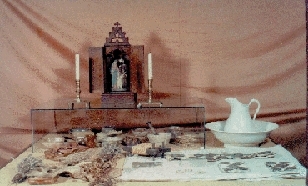4. Folk Medicine and Parallel Medicines

Traditional medicines constitute an important heritage of all the people in the world that developed popular medical cures and beliefs. These practices were based on what nature provided them and influences from other cultures. They have been called folk medicine in Europe from the time the first book on the subject was published [Black, W.G.: Folk-Medicine. London, E. Stock, 1883]. Many books and articles on this subject have been published since then.
Firstly, domestic medicine treatments are exhibited; treatments which derived from what were traditionally used by our people; such as medicinal plants, animal derivatives, ordinary objects, ointments, etc.
Belief medicine is based on worship and traditions related to approximately thirty healer saints known in Christianity. These healers specialized in different pathologies (St. Blaise for the throat; St. Apollonia for the teeth; St. Lucy for the eyes, etc.). These religious practices can be seen in the items and sanctuaries related to the topic.
The protection of children and adults encouraged the use of "gospels", amulets and other elements. Witchcraft and some of its surviving beliefs, such as the evil eye, also generated magical amulets and folk remedies.
Parallel medicine (homeopathy, acupuncture, etc.) are displayed in an independent stand. They include, among other objects, suction pads used until the mid-twentieth century, a phrenologic head, and materials and pictures of spas in Navarre (collected by Kepa Lizarraga).
The room is dedicated to the ethnographer and archaeologist José Miguel de Barandiarán (1889-1991), who was closely connected to the birth and development of the museum.

